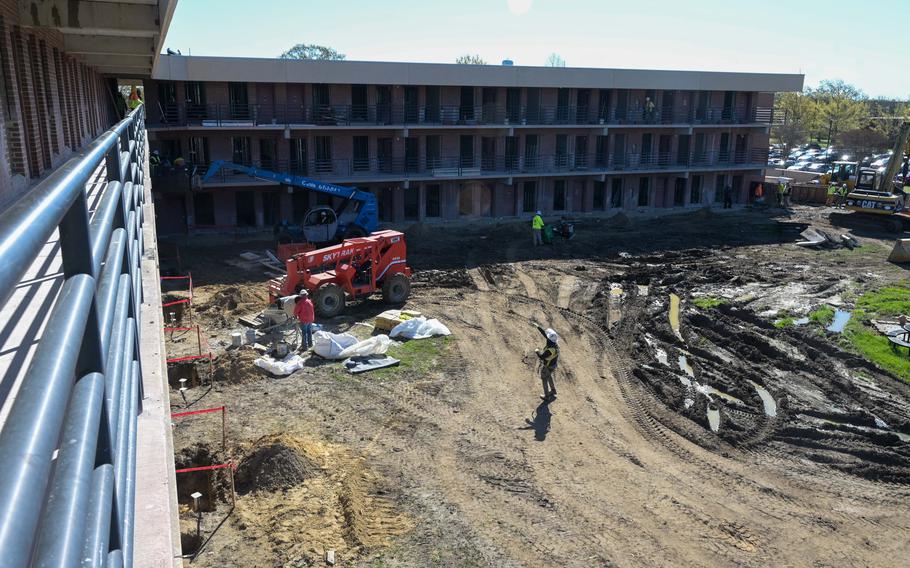
Renna Hall dormitories being renovated April 5, 2024, at Joint Base Langley-Eustis, Va. (Adisen Smith/U.S. Air Force)
The number of military construction projects delayed for more than a year has doubled in the last five years and the problem could be mitigated through better oversight from the Defense Department, according to a new government watchdog report.
The Government Accountability Office found the number of projects delayed jumped from 73 to 158 from 2019 to 2024. More so, 25% of all projects in that time delayed for at least a year, which can happen for a variety of reasons, can increase the construction costs of the project by millions of dollars. GAO investigators focused their review largely on the design phase of projects that is typically overseen by the Army Corps of Engineers and the Naval Facilities Engineering Systems Command.
The Defense Department closely watched a handful of high-profile projects but heavily relied on those two organizations to monitor progress. Some facilities included in military construction are child care facilities, aircraft hangars, roads and barracks.
“We definitely think more oversight is needed here given the magnitude of the issue,” said Alissa Czyz, director the defense capabilities and management team at GAO. She authored the report released Monday titled “Military Construction: Better Information Sharing Would Improve DOD’s Oversight.”
At the close of fiscal 2023, which ended Sept. 30 of that year, the military had about 598 ongoing construction projects worth more than $28 billion, according to the report.
Military officials have requested $15 billion in funding for fiscal 2025 for new construction.
The report highlighted some of the majorly delayed projects across the military, such as a communications and crypto facility at Joint Base Pearl Harbor-Hickam in Hawaii that was supposed to be completed in April 2021 for a total of $49.8 million. Construction is ongoing and the cost for the project has grown to $124 million, in part because of design errors, material delays and issues with heating and cooling systems.
The financial costs of delayed construction don’t quantify the loss to operations from the stalled projects when new facilities are put on hold as building drags on. The Hawaii facility is meant to improve the Navy’s ability to conduct information warfare missions.
The delays also contribute to other ongoing problems such as the shortage of child care facilities and housing for junior enlisted.
A GAO report last year found junior troops were suffering with poor living conditions in barracks and dorms. Problems included sewage overflow, mold, water-quality issues, rodent infestations, broken air conditioning and missing kitchenettes. Some installations, such as Fort Cavazos in Texas, do not have enough rooms in barracks, which has forced some soldiers to double up.
As the military services wait for new child care facilities, officials have had to get creative with unused space on bases to reduce the waitlists for care. At Naval Air Station Patuxent River in Maryland, officials converted an old conference center into a youth center.
Czyz said investigators tried to pin down a reason why the number of delayed construction projects continues to increase but found there were so many contributing factors that they could not find a clear answer.
For road construction at Camp Lejeune, N.C., the project was delayed for more than two years in part because of significant rainfall and contractors striking a utility pipe that they were unaware existed at the site. Officials told the GAO that the design phase didn’t include a completed survey with data about utilities, and a 24-inch water line was discovered during construction.
“[Navy] officials emphasized that a lesson learned from this project could be to invest more money into quality surveys at the beginning of the project rather than dealing with issues during construction,” according to the report.
The report offered seven recommendations to improve oversight that focused on better documentation, analysis and review of projects to track trends and lessons learned, as well as training personnel to document post-project reviews and validate the information.
Michael Rosenblatt, director of military construction at the Pentagon, wrote to the GAO that the Defense Department agreed with the recommendations. However, he did not provide a timeline to implement them.
Czyz said she did not anticipate the changes would create a burden for the military because they’re collecting information already.
“They agree that it’s something that they can do,” she said.